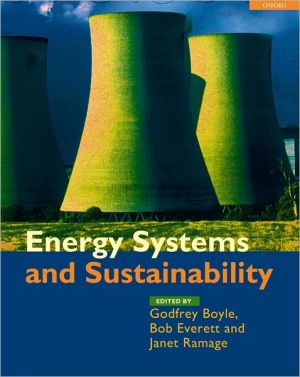

 |

|

The average rating for Energy Systems and Sustainabilit based on 2 reviews is 4 stars.
Review # 1 was written on 2014-12-11 00:00:00 Erik Mjanger Erik MjangerNot Read Completely, But It Is Surely A Good Books On Basics Of Alternative Energy. |
Review # 2 was written on 2014-04-05 00:00:00 John Bennett John BennettThe real deal on the future of the hydrogen economy Having read Jeremy Rifkin's interesting, but rose-colored and somewhat tangential take on the future of the hydrogen fuel cell: The Hydrogen Economy: The Creation of the World-Wide Energy Web and the Redistribution of Power on Earth (2002), I was pleased to read something from a full-time energy professional. Joseph Romm, author of this sobering volume, worked in the Department of Energy in the Clinton administration and has been involved intimately with hydrogen research and development for many years. His main point is that we must eventually have a hydrogen economy based on the hydrogen fuel cell, but that we must not expect this to happen without some major technological breakthroughs. His book is a warning that the global warming clock is ticking and ticking, and that we need to do something now if we hope to avoid a possible catastrophe. The really scary thing about global warming is that we may pass over the point of no return without knowing it. Furthermore, a full-blown, runaway greenhouse effect would make nuclear winter look like a walk in the park. Look what happened to Venus, where on any spring day (or winter day for that matter) the surface is hot enough to melt lead. Could that happen here? The real and direct answer to that question is: we don't know. Romm is not painting any such dire scenarios in this book, but he does state most clearly that "the primary reason why we should pursue fuel cells and a hydrogen economy is to help respond to global warming." (p. 188) He adds, "global warming is the most intractable and potentially catastrophic environmental problem facing...the planet this century." (p. 152) Romm identifies carbon dioxide emissions into the atmosphere as the primary cause of global warming. What to do and how to do it? Because Romm addresses these questions in such compelling detail, this is the book I believe that will be--if it hasn't already been--read by high-ranking government officials and the CEOs of energy corporations throughout the world. I hope that Sen. John Kerry and President George W. Bush will read it. What they will find is that it will require a closely co-ordinated effort on the part of both government and the private sector to bring about a cost-effective hydrogen technology. This technology will include the building of an infrastructure for making and distributing hydrogen that will cost hundreds of billions of dollars. Romm makes it clear that none of this will happen until hydrogen becomes competitive with fossil fuels in terms of cost and efficiency. Right now hydrogen is most cheaply made from fossil fuels themselves, a process that does not reduce green house gases, and furthermore is much more expensive, no matter what currently-available technology is used, than gasoline itself, and will remain so for many years, probably decades, to come. Ultimately the goal is to manufacture hydrogen from water using renewable resources such as biomass, wind, sun, downward running water, evaporation, ocean currents, etc. to split the water molecule into its component elements. Romm's immediate future scenario has us obtaining hydrogen from natural gas while using our renewable energy resources to produce electricity in an effort to begin to slow the belching of carbon dioxide into the air. Romm believes that oil production will probably peak in the first half of this century. He adds that "Some believe this will occur by 2010." (p. 16) Given this, it is obvious that we will have to come up with some sort of fuel to replace oil. Since only "a limited number of fuels are plausible alternatives for gasoline" (p. 16), and since the one with the most going for it is hydrogen, it will be hydrogen. But transporting hydrogen the way we transport gasoline will be more expensive, perhaps prohibitively expensive since it has to be condensed and/or made into a very cold liquid under pressure. One might think we could transport water instead and make hydrogen at hydrogen stations, but the most efficient conversion methods require large scale operations at high temperatures. There are several other very challenging problems to be faced, not the least of which is what Romm identifies as "the chicken or the egg" conundrum. That is, automakers will not make hydrogen fuel cell cars until the hydrogen infrastructure is in place, and the infrastructure will not appear until there are a sufficient number of fuel cell cars on the road. While I think Romm maintains a cautious level of optimism in the face of these difficulties, he does on occasion let his pessimism show: "If the actions of Saddam Hussein and Osama Bin Laden and record levels of oil imports couldn't induce lawmakers, automakers, and the general public to embrace EXISTING vehicle energy efficiency technologies...I cannot imagine what fearful events must happen before the nation will be motivated to embrace hydrogen fuel cell vehicles, which will cost much more to buy...to fuel, and require massive government subsidies to pay for the infrastructure." (p. 162) If you want to know where we really are vis-vis the so-called hydrogen economy, read this book. --Dennis Littrell, author of "The World Is Not as We Think It Is" |
CAN'T FIND WHAT YOU'RE LOOKING FOR? CLICK HERE!!!